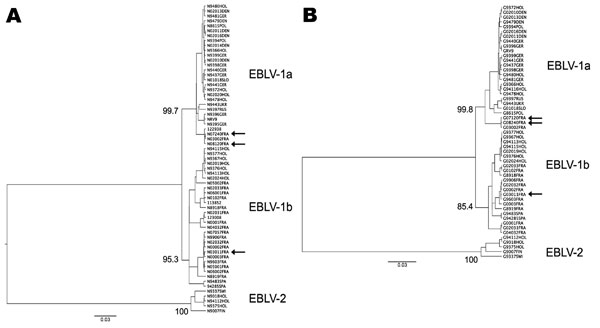Volume 15, Number 2—February 2009
Dispatch
European Bat Lyssavirus Transmission among Cats, Europe
Figure 1

Figure 1. Phylogenetic tree comparing nucleotide sequences of A) nucleoprotein (372 nt, position 63 from the translation initiation site) and B) glycoprotein (547 nt, position 640 from the translation initiation site) genes of spillover transmission of European bat lyssavirus-1 (EBLV-1) in terrestrial mammals and human with representative isolates of the diversity of EBLV-1 in Europe. Cases described in this report are indicated by the arrows. For each dataset, we inferred a maximum clade credibility phylogenetic tree by using the Bayesian Markov Chain Monte Carlo method available in the Bayesian Evolutionary Analysis Sampling Trees software (http://beast.bio.ed.ac.uk). This analysis used a relaxed (uncorrelated lognormal) molecular clock and the HKY85 + Γ4 model of nucleotide substitution. All horizontal branches are scaled according to the number of substitutions per site. Bootstrap values are indicated at the nodes. All GenBank accession numbers corresponding to full-length or partial nucleoprotein and glycoprotein nucleotide sequences were previously described (2,10) except for nucleoprotein nucleotide sequences of isolates 03011FRA (EU636795), 04032FRA (EU636794), 05001FRA (EU636790), 05002FRA (EU636789), 06001FRA (EU636791), 06002FRA (EU636792), and 070057FRA (EU636793) and glycoprotein nucleotide sequences of isolates 03011FRA (EU636787) and 04032FRA (EU636788).
References
- Bourhy H, Dacheux L, Strady C, Mailles A. Rabies in Europe in 2005. Euro Surveill. 2005;10:213–6.PubMedGoogle Scholar
- Davis PL, Holmes EC, Larrous F, Van der Poel WH, Tjørnehøj K, Alonso WJ, Phylogeography, population dynamics, and molecular evolution of European bat lyssaviruses. J Virol. 2005;79:10487–97. DOIPubMedGoogle Scholar
- Harris SL, Brookes SM, Jones G, Hutson AM, Racey PA, Aegerter J, European bat lyssaviruses: distribution, prevalence and implications for conservation. Biol Conserv. 2006;131:193–210. DOIGoogle Scholar
- Vos A, Kaipf I, Denzinger A, Fooks AR, Johnson N, Müller T. European bat lyssaviruses: an ecological enigma. Acta Chiropt. 2007;9:283–96. DOIGoogle Scholar
- Amengual B, Bourhy H, López-Roig M, Serra-Cobo J. Temporal dynamics of European bat lyssavirus type 1 and survival of Myotis myotis bats in natural colonies. PLoS One. 2007;2:e566. DOIPubMedGoogle Scholar
- Tjørnehøj K, Fooks AR, Agerholm JS, Rønsholt L. Natural and experimental infection of sheep with European bat lyssavirus type-1 of Danish bat origin. J Comp Pathol. 2006;134:190–201. DOIPubMedGoogle Scholar
- Müller T, Cox J, Peter W, Schäfer R, Johnson N, McElhinney LM, Spill-over of European bat lyssavirus type 1 into a stone marten (Martes foina) in Germany. J Vet Med B Infect Dis Vet Public Health. 2004;51:49–54. DOIPubMedGoogle Scholar
- World Health Organization. WHO expert consultation on rabies. World Health Organ Tech Rep Ser. 2005;931:1–88.PubMedGoogle Scholar
- Xu G, Weber P, Hu Q, Xue H, Audry L, Li C, A simple sandwich ELISA (WELYSSA) for the detection of lyssavirus nucleocapsid in rabies suspected specimens using mouse monoclonal antibodies. Biologicals. 2007;35:297–302. DOIPubMedGoogle Scholar
- Delmas O, Holmes EC, Talbi C, Larrous F, Dacheux L, Bouchier C, Genomic diversity and evolution of the lyssaviruses. PLoS One. 2008;3:e2057. DOIPubMedGoogle Scholar
- Conseil Supérieur d’Hygiène Publique de France (CSHPF). Recommandations pour limiter l’exposition du public aux virus de la rage des chauves-souris. Bulletin Epidémiologique Hebdomadaire. 2001;39:193.
- Takumi K, Lina PH, van der Poel WH, Kramps JA, van der Giessen JW. Public health risk analysis of European bat lyssavirus infection in The Netherlands. Epidemiol Infect. 2008;21:1–7. DOIGoogle Scholar
- Tjørnehøj K, Rønsholt L, Fooks AR. Antibodies to EBLV-1 in a domestic cat in Denmark. Vet Rec. 2004;155:571–2.PubMedGoogle Scholar
- Brookes SM, Klopfleisch R, Müller T, Healy DM, Teifke JP, Lange E, Susceptibility of sheep to European bat lyssavirus type-1 and -2 infection: a clinical pathogenesis study. Vet Microbiol. 2007;125:210–23. DOIPubMedGoogle Scholar
- Marston DA, McElhinney LM, Johnson N, Müller T, Conzelmann KK, Tordo N, Comparative analysis of the full genome sequence of European bat lyssavirus type 1 and type 2 with other lyssaviruses and evidence for a conserved transcription termination and polyadenylation motif in the G-L 3′ non-translated region. J Gen Virol. 2007;88:1302–14. DOIPubMedGoogle Scholar